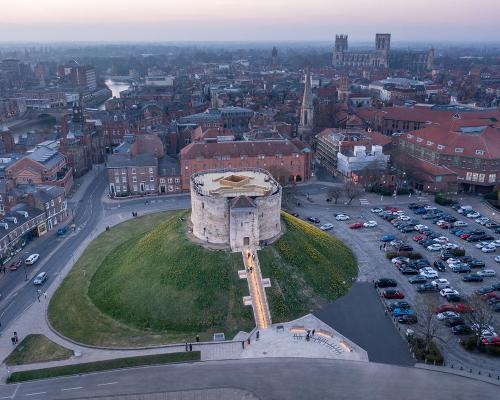06 Apr 2022
Clifford's Tower opens to the public after £5m redevelopment
BY Tom Walker

Clifford’s Tower in York, considered one of England’s most important buildings, has opened to the public following a £5m redevelopment.
The structure is all that remains of York Castle, which was built on the orders of William I and once dominated the former Viking city of Jórvík.
While the landmark has played a crucial role in English history during its 800-year-old history, it had been pretty much an empty shell since it was gutted by a fire in 1684 when it was used as a store for armaments and gunpowder.
As a result, it had never become a popular visitor attraction.
Now, thanks to designs by Hugh Broughton Architects (HBA) – who worked with conservation specialists Martin Ashley Architects – the tower has received a new lease of life.
Visitors will now be able to explore the tower – owned and operated by English Heritage – thanks to a free-standing timber structure that has elegant aerial walkways.
An enlarged public area at the base of the motte now incorporates interpretation and accommodates an English Heritage-branded Piaggio, with an interior designed by HBA, for the sale of tickets and guidebooks.
It offers a ground-level place to engage with visitors, including those unable to ascend the tower.
The design was developed in consultation with multiple stakeholders both within English Heritage and Historic England and in the wider city community including the Museums Heritage Trust, York Civic Trust, City Council and the Conservation Area Advisory Panel.
Hugh Broughton Architects said: "Our work for English Heritage at Clifford’s Tower demonstrates our skills in designing technically challenging and appropriate interventions within the context of a Scheduled Ancient Monument, improving access and visitor facilities whilst fostering better interpretation of the site and Monument’s history.
"The project includes vital conservation works as well as architectural improvements which enhance the visitor experience.
"To address the shortfalls in experience and facilities, a timber structure has been installed to partially cover the ruin and provide fantastic viewing and activity space at roof level. Suspended metal walkways give access to previously unseen features at first-floor level, enhance access to the roof and help celebrate the ruin.
"The structure of the intervention rests on a raft foundation, which spreads load without impact on archaeology within the tower."
Close Window